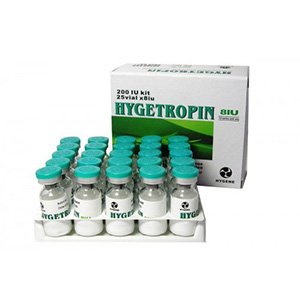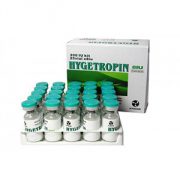Hygetropin 8IU for sale online
Manufacturer: Hygene
Category: HGH
Substance: Somatropin
Package: 1 vial x 8IU, 1 Kit 200IU
Backorder
The human body has its own way of regulating and enhancing its performance. The muscles have to be rejuvenated at every instant to ensure they are at the peak of their performance. To accomplish this, there is the natural growth hormone that is continually emitted into the body muscles to help replenish any waning performance. When it comes to the human body however, there is a limit to how much of this hormone can be produced and also a limitation in how far it can enhance muscles performance. This is what led to the development of an artificial hormone, hygetropin, which is a copy of the natural growth hormone. Hygetropin, or Human Growth Hormone (HGH) as is widely known, has a number of benefits to the body including improved muscle performance, anti-aging benefits and weight-loss.
One huge benefit of Hygetropin HGH is that it results to improved energy levels and metabolism. A look at the human body indicates that there is a huge quantity of GH produced in the body in the natural way during youthful age and puberty. This is the hormone responsible for the hyperactivity that characterizes the lives of young children and teenagers. The amount of GH produced by the body however decreases as an individual advances in age. For those engaging in vigorous activities hence, a dose of Hygetropin HGH increases the level of energy and infuses a high level of metabolism. This can lead to burning of more fat as the body seeks for more energy in the reserves, which eventually results into significant weight loss at a higher level and at a far much increased pace, than other methods.
Hygetropin is, unlike most hormones used by bodybuilders, not a steroid hormone, but a proteinaceous hormone made up of a chain of 191 amino acids. All animals have growth hormone, but each seems to be specific to the species. HGH was first isolated in the late 70’s and early 80’s as a biological form. The hormone was literally extracted from the pituitary of deceased individuals. As with anything extracted from carcasses this imposed a serious risk of contracting the Kreutzfeld-Jacob disease (since the late 90’s best known as mad cow disease), a normally rare neural infliction that makes you spastic and can cause death over a period of no more than two weeks. Not exactly appealing. There also wasn’t, understandably, much demand for such a compound on the black market. Late 80’s early 90’s geneticists succeeded in manufacturing a genetic form of HGH however, through a very complicated technique using mice genes and what have you not (I’m not a geneticist, don’t ask me). This also seriously upped the price of the compound. But around that time, mainly due to this safer form, some top-level athletes were taking an interest. With increasing drug tests making the most effective anabolics forbidden territory, a pharmaceutical race to find replacement compounds that could not be detected had begun. And since then several athletes have and are still using HGH. It’s a very mythical compound, since professionals will use it in high doses and make obvious improvements, yet most recreational users seeking to try it have to settle for lower doses and get little if anything out of it in terms of lean muscle mass increases. Along with several human studies that clearly document that HGH administration offers us no benefit in this aspect, it makes one wonder. Its terribly expensive and most people seem to get nothing out of it. So is it really worth it when extremely effective steroids can be bought for the proverbial nickel and dime? I don’t think so, but I’ll get back to that later. Human Growth Hormone is primarily secreted in rhythmic pulses during sleep. This occurs by the mechanism of Growth Hormone Releasing Hormone and Somatostatin being released in an alternating fashion. For the most part users will want to mimic the natural release of growth hormone, while also not disrupting the body’s natural production of the hormone. This is often a delicate balance. In terms of a dosing schedule for the compound, there is some controversy as to the best method for fat loss/anabolism. It is thought by many that daily dosing is of primary importance when using Hygetropin due to the extremely short active life of the drug. Blood concentrations of the hormone reach their peak within two to six hours of the injection, with the half life being only twenty to thirty minutes. This of course makes it impossible to maintain stable blood levels of the compound. However a stable level of the hormone is seemingly unnecessary as this does not occur naturally when the body produces the hormone. In fact there is some research that indicates that administration of the hormone every other day, instead of injections every day, may result in a more efficient use of the hormone. In a study using children ranging in ages of two to four, it was demonstrated that administration of the compound every other day, as opposed to every day, resulted in more growth in the children giving this dosing schedule. One theory as to why this may occur is that injections every other day may simulate the natural pulsile frequency of Growth Hormone secretion. This would also allow the Growth Hormone receptors in the body recover from the surge of Growth Hormone that would be circulating and then be better able to make use of the next dose that is administered the next day. The only problem with the above theory is that it has never been tested in terms of its effect on muscle growth and/or fat loss, only in the height growth in extremely young children. For the most part strength athletes and bodybuilders have administered growth hormone every day and have achieved good results. This method would seemingly provide a user with a consistent wave of Growth Hormone throughout their cycle and allow the body to utilize it rather efficiently. Another common practice among users is to run Hygetropin for five days and then take one or two days off, or some other similar schedule. This would seemingly be “splitting the difference” between the two dosing schedules outlined above, but there is no research to indicate that it is of any significant benefit either way. As for the time of day a user should inject Hygetropin, it would be least disruptive to the natural release of the hormone to administer it sometime early in the day. If a user were to inject it close to when they were going to sleep, this would surely negate any natural release of HGH, something that a user would obviously want to avoid. There is no standard to which most adhere to when deciding how close to going to sleep that they will administer Hygetropin, however mid-afternoon should be early enough that it does not interfere with the natural release of the hormone during sleep. In terms of dosages needed to see specific results, there is primarily only anecdotal evidence to be relied upon when it comes to fat loss and an anabolic response. The relevant research does not discuss these effects in any great scope. However, most users have indicated that doses of approximately two to six international units per day in men will usually produce a noticeable loss of body fat in most users. In terms of getting an anabolic response, the experience of users vary considerably. For the most part it can be concluded that most users will need to administer larger doses than needed to experience fat loss if they wish to see a noticeable anabolic response from Hygetropin . How much more varies from individual to individual. There are some users who have indicated that using extremely large doses of the hormone has resulted in dramatic gains in muscle mass, but often these doses are cost prohibitive for most. Individuals will likely have to experiment themselves to find a level that they are comfortable with, as well as what they can afford. As for the duration of a cycle of HGH, it is believed by many that the compound must be administered for a minimum of 20 to 30 weeks to see results. The action of the compound is slow acting and therefore lengthy cycles are needed. However due to its relative safety it can be run for several months, and even years, with little to no negative results. Of course this is dependent on the user and his or her individual reaction to the compound, along with the doses that they are using. Hygetropin can be administered using either intra-muscular or subcutaneous injections. There is no difference in the absorption of the compound. No type of post-cycle therapy is necessary when discontinuing Hygetropin as it should continue to be produced naturally by the body of the user. The negative feedback loop that indicates to the body that there is enough of the hormone circulating is related to insulin-like growth factor. Specifically, when insulin-like growth factor is secreted by the liver a signal is sent to the pituitary gland and hypothalamus to cease the production of Growth Hormone.
There people who opt for steroids to enhance their performance often end up with abnormally large muscle mass. When it comes to the Hygetropin HGH however, it results to lean muscle development. Any instances of weight gain are gradual in measured steps. Hygetropin HGH leads to the development of additional muscle cells meaning that an individual enhances his or her genetic capabilities achieving physical fetes that would not be normally achievable. It is also widely used as anti-aging substance in addition to other uses. This increased synthesis of new muscles and cells makes it possible to maintain a youthful appearance. These anti-aging benefits however, according to researchers, can be explained by the improved sleep pattern and healthier body organs.





